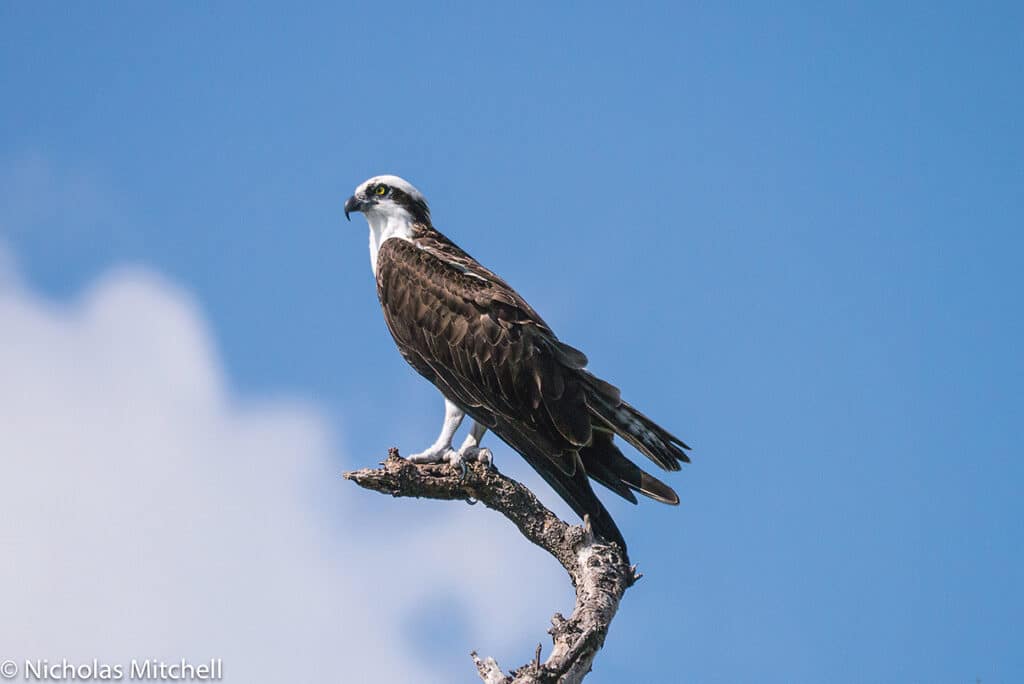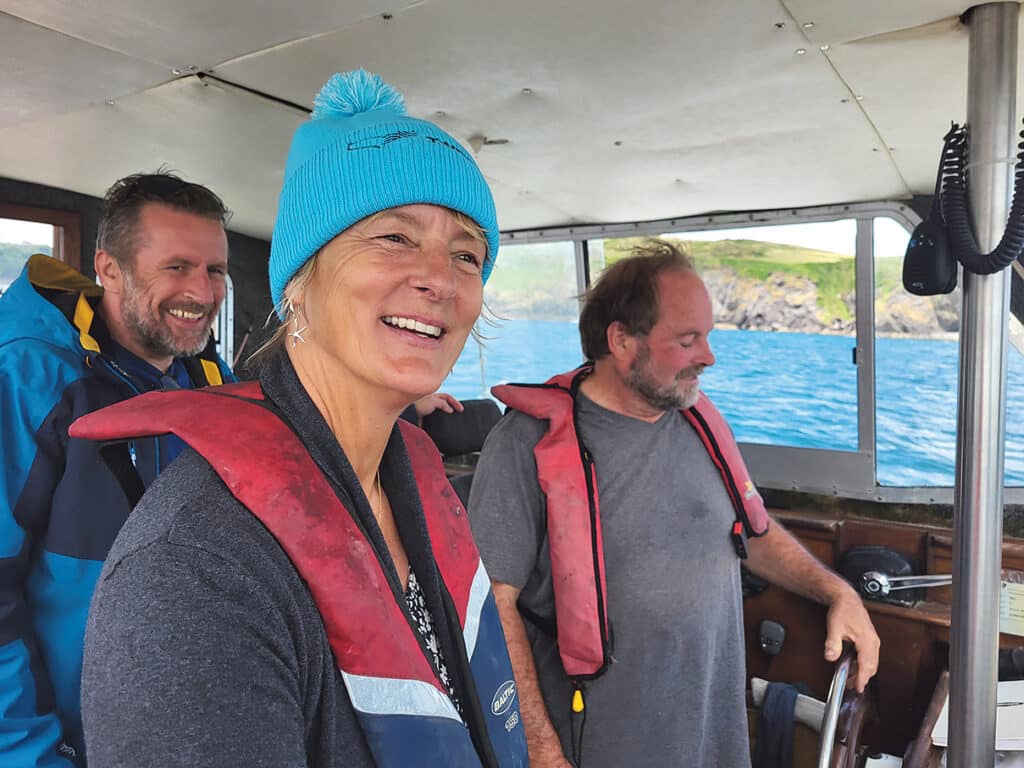This month, Branch Committee Member and local National Parks and Wildlife Service Conservation Ranger Dave Rees writes about the Osprey, Pandion haliaetus.

As we head into the late summer months of July and August, if you’re near any of our beaches and estuaries, keep an eye out for the magnificent Osprey. This spectacular bird of prey is one that always stops birdwatchers in their tracks. Not just because of their striking looks but also because of the chance to watch them fishing. This is when the bird will plunge into the water with an audible splash, sometimes disappearing completely under the surface (or seemingly so) only to reappear clutching a wriggling fish in its talons. The bird will then fly off to a convenient perch, carrying the fish in a particular way so that the fish’s head points forward, presumably to reduce any drag that a struggling fish might cause. If you’ve ever witnessed an Osprey fishing, it is a sight that you are likely to never forget.
Ospreys are migrant birds, spending the winters in west Africa before returning to their breeding grounds. At the moment, Ospreys don’t breed in Ireland (more of that later) and the nearest breeding populations are in Wales, England and Scotland. The birds that we get to see are on migration, sometimes on the spring passage when the birds are moving north to return to their breeding sites, but more often on Irish coasts in late summer as the birds are on the return journey to the wintering grounds. Locally, good sites to watch out for Ospreys are Timoleague and Courtmacsherry estuary, Clonakilty Bay and Roaringwater Bay. Birds are regularly seen in Cork Harbour and further east along the Waterford and Wexford coasts. But it’s not just coastal sites; Ospreys have been recorded inland at Inchigeelagh, the Gearagh and the river Blackwater valley.
They are nearly always found close to the coast or large bodies of water inland as they feed exclusively on fish. In estuaries they will catch mainly mullet and bass with some flatfish too, whereas inland they can take salmon and trout. In Scotland, close to the famous Loch Garten nest site, one enterprising trout farm now charges people to come in to watch and photograph Ospreys catching their trout, giving the farm an additional income.
Ospreys are found throughout the world and are present on every continent except Antarctica. In Europe their population numbers have fluctuated but now appear to be on the increase, with the European population estimated to be between 9,500 and 13,500 pairs. There is some debate as to whether Ospreys historically breed in Ireland. However, Giraldus Cambrensis (‘Gerald of Wales’), a 12th Century clergyman, travelled throughout Ireland and provided a compelling description of fishing Ospreys. Interestingly, he describes them as having two different feet, one with webbing to allow them to swim in the water, and the other with talons to allow them to grab hold of the fish that they had caught. In the 1700s, a naturalist visiting Killarney wrote to the famous naturalist, Gilbert White, saying that locals had told him that Ospreys nested on the lake.
It has been suggested that further evidence for the Ospreys in Ireland comes from the Irish name for Osprey, ‘Iascaire Coirneach’. In Rosscarbery, there is a townland ‘Baile na gCoirneach Thiar’. Could this be a reference to Osprey?
If Ospreys did occur in Ireland, it is not known what could have caused their decline and subsequent disappearance from our landscape. In the UK, it is thought that persecution may have led to them becoming extinct before they successfully recolonised Scotland in the 1950s. Since then, the birds have increased in numbers in Scotland, whilst in England a successful reintroduction project has led to them becoming established in east England and a second project is ongoing to reintroduce them to the south of England. Birds from the first reintroduction in England spread to Wales and there is now a thriving population in Wales.
So, could a reintroduction project see these birds start breeding in Ireland? Research has shown that it is highly unlikely that birds that migrate through Ireland will stop and breed, so they may well need a helping hand. In May this year, the National Parks and Wildlife Service announced plans to reintroduce Ospreys to Ireland. Over the next five years, it is planned to bring in between 50 and 70 chicks from Norway and to release them at a site in the southeast of the country. Alongside this, a programme of building nesting platforms at suitable locations will also be undertaken in the hope that this will encourage the birds to nest. Let’s hope that the project is a success so that we don’t have to wait for our twice-yearly chance to see Ospreys in Ireland. It would be wonderful to have them as breeding birds. In the meantime though, keep your eyes out if you’re around the coast for the sight of this magnificent Fisher King.
Branch News
Upcoming outings:
Sunday, June 30
– Visit Long Island
Sunday, July 30 – National Heritage Week – Rosscarbery
Visit our website www.birdwatchirelandwestcork.ie for more information about these events. To receive news and reminders about our events join our mailing list by sending an email to mailinglist@birdwatchirelandwestcork.ie. For more information about the Branch, contact Fiona O’Neill at secretary@birdwatchirelandwestcork.ie.
Facebook
@BirdWatchIrelandWestCork
Twitter @BWIWestCork


